
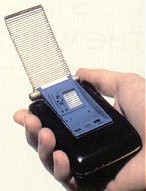 Moving on from the uniforms to the equipment. This is one piece of equipment you should never be without - a communicator. All Starfleet personnel are issued with a communicator. This device has been the mainstay of Starfleet since it's creation over one hundred and thirty years ago. The communicator is your lifeline to your starship and colleagues during Away Team missions. The communicator has access to thousands of channels, emergency channels and is also capable of being used as a weapon as a last resort. The communicator is the standard communications device and we train all cadets in the use of Starfleet equipment including the communicator. By the time you finish the course, you will know how to fix, jury-rig, disassemble and reassemble all standard Starfleet equipment with a blindfold on.
Moving on from the uniforms to the equipment. This is one piece of equipment you should never be without - a communicator. All Starfleet personnel are issued with a communicator. This device has been the mainstay of Starfleet since it's creation over one hundred and thirty years ago. The communicator is your lifeline to your starship and colleagues during Away Team missions. The communicator has access to thousands of channels, emergency channels and is also capable of being used as a weapon as a last resort. The communicator is the standard communications device and we train all cadets in the use of Starfleet equipment including the communicator. By the time you finish the course, you will know how to fix, jury-rig, disassemble and reassemble all standard Starfleet equipment with a blindfold on.
Author's note: It isn't known when combadges are introduced, but with wrist communicators in ST:TMP, it must surely only be a matter of time before Starfleet figures out the benefits of a combadge system. Communicators are found in all starships currently, but U.S.S. Ambassador is to have the new combadge system installed and trialled when constructed to evaluate the system for installation universally after that. My friend Nick argues the combadge doesn't appear until the Enterprise-C era, and I am inclined to agree that it will not be until the Ambassador class [the next generation of starship] that we will see the appearance of the combadge.
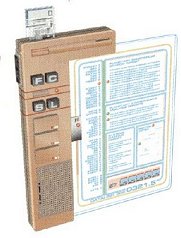 This is a PADD - Personal Access Display Device. This is one piece of equipment that as a Starfleet Cadet you will never be without. This allows you to write information down, transfer it to a computer or retrieve information from a computer, manipulate it, review it and then transfer the final report elsewhere. The PADD can perform uplink functions to either starbase, shipboard or Starfleet Web access. You can theoretically operate a starship from a PADD, although it isn't recommended. PADD's can also accept vocal input and have the usual high level security protection found on all Starfleet equipment.
This is a PADD - Personal Access Display Device. This is one piece of equipment that as a Starfleet Cadet you will never be without. This allows you to write information down, transfer it to a computer or retrieve information from a computer, manipulate it, review it and then transfer the final report elsewhere. The PADD can perform uplink functions to either starbase, shipboard or Starfleet Web access. You can theoretically operate a starship from a PADD, although it isn't recommended. PADD's can also accept vocal input and have the usual high level security protection found on all Starfleet equipment.
Author's note: this particular model of PADD was only ever seen in Star Trek VI and the Voyager episode 'Flashback' aboard the Excelsior. The PADD, for me, is the item of equipment that should be prominently visible aboard a starship or starbase. Given the usefulness of a PADD, I often wonder why I haven't bought one for myself to do all this typing on...
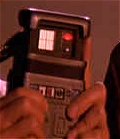
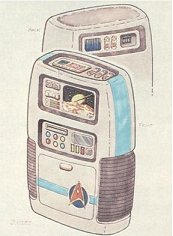 This piece of equipment is another that will never leave your side: the Tricorder. Starfleet is all about exploration and "Boldly going", and you cannot do that without a tricorder. A tricorder is a multi-functional device that is used for scanning objects, areas and pretty much anything you point it at. There are various types of tricorder including the medical tricorder. These other types of tricorder are more specially suited to specialist tasks such as biomonitoring and scanning organic lifeforms. For the simplicity of this introduction I shall talk about just the general tricorder that you will all have to use at some point in the next four years, and certainly often once you have graduated.
This piece of equipment is another that will never leave your side: the Tricorder. Starfleet is all about exploration and "Boldly going", and you cannot do that without a tricorder. A tricorder is a multi-functional device that is used for scanning objects, areas and pretty much anything you point it at. There are various types of tricorder including the medical tricorder. These other types of tricorder are more specially suited to specialist tasks such as biomonitoring and scanning organic lifeforms. For the simplicity of this introduction I shall talk about just the general tricorder that you will all have to use at some point in the next four years, and certainly often once you have graduated.
The tricorder can scan, as I have mentioned, and it can also record sounds, visual items as well as recording the data from whatever it is scanning. The tricorder can upload the information to a starship or starbase, as well as being able to cross-reference it's findings with the nearest Starfleet computer.
The tricorder has a belt that allows it to be slung over the shoulder when not in use, alternatively it can also be affixed to the belt of your uniform, although this can be cumbersome at times.

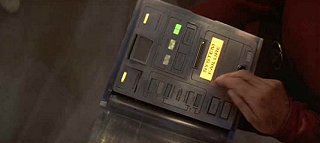
The Captain's Log is an important piece of starship hardware - at least to the Commanding Officer. This device will be the prime source of information on the activities of a starship during the mission. The Captain's Log is carried by the yeoman and is available for the captain to record into at any time. Occasionally the log has been known to malfunction, but this is a rarity.
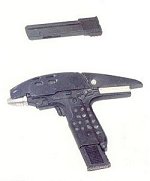
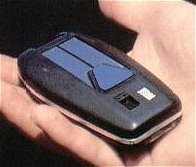 The phaser is the defensive weapon carried by Starfleet personnel. The most common phaser in use is the Type 2 phaser [shown left and below]. The phaser has 8 settings, although the one here, as with all Academy phasers, are limited to just the two stun settings. I shall briefly describe the 8 settings for you. Settings 1 - 2 are stun settings. Setting one will stun an average humanoid for up to five minutes. Setting two will stun an average humanoid for about half an hour. Setting three and upwards causes damage to the target including heat damage and eventually disruption of the nuclear forces holding the target together. A phaser on setting 5 and upwards will vapourise a humanoid target.
The phaser is the defensive weapon carried by Starfleet personnel. The most common phaser in use is the Type 2 phaser [shown left and below]. The phaser has 8 settings, although the one here, as with all Academy phasers, are limited to just the two stun settings. I shall briefly describe the 8 settings for you. Settings 1 - 2 are stun settings. Setting one will stun an average humanoid for up to five minutes. Setting two will stun an average humanoid for about half an hour. Setting three and upwards causes damage to the target including heat damage and eventually disruption of the nuclear forces holding the target together. A phaser on setting 5 and upwards will vapourise a humanoid target.
Starfleet officers are issued with a Type 1 phaser [above right] as a personal sidearm, Type 2 will be issued for Away Team missions. Type 3 phaser rifles are used during extreme situations and training for the use of these weapons is limited to security personnel. Phasers are protected by smart technology built into them. A phaser cannot be used at a setting on a starship that will damage the integrity of the ship. The phaser also has smart technology built into it to prevent unauthorised useage.
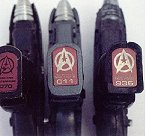 The Type 2 phaser also has the facility to change the charge pack and thus recharge the phaser with a new supply in under 30 seconds, a vital aspect in a firefight situation. The security coding also means a phaser can be traced to the ship or base from which it came from.
The Type 2 phaser also has the facility to change the charge pack and thus recharge the phaser with a new supply in under 30 seconds, a vital aspect in a firefight situation. The security coding also means a phaser can be traced to the ship or base from which it came from.
Author's note: My friend Nick pointed out that earlier phasers would probably have a different range of settings to Next Generation era 'Dustbuster' models. I therefore came up with the idea that earlier phasers probably were less precise with their power settings (less buttons and displays for power settings] I thus simplified the settings to 8 settings [instead of the future 16].
 Should you get into a situation where combat is anticipated, security-trained personnel may be issued with phaser shields. These shields will protect the bearer from all projectile weaponry fire and most phaser and disruptor settings. The shields are transparent, to allow ease of operation.
Should you get into a situation where combat is anticipated, security-trained personnel may be issued with phaser shields. These shields will protect the bearer from all projectile weaponry fire and most phaser and disruptor settings. The shields are transparent, to allow ease of operation.
"The above artwork is © Interplay Productions. All rights reserved"









 Moving on from the uniforms to the equipment. This is one piece of equipment you should never be without - a communicator. All Starfleet personnel are issued with a communicator. This device has been the mainstay of Starfleet since it's creation over one hundred and thirty years ago. The communicator is your lifeline to your starship and colleagues during Away Team missions. The communicator has access to thousands of channels, emergency channels and is also capable of being used as a weapon as a last resort. The communicator is the standard communications device and we train all cadets in the use of Starfleet equipment including the communicator. By the time you finish the course, you will know how to fix, jury-rig, disassemble and reassemble all standard Starfleet equipment with a blindfold on.
Moving on from the uniforms to the equipment. This is one piece of equipment you should never be without - a communicator. All Starfleet personnel are issued with a communicator. This device has been the mainstay of Starfleet since it's creation over one hundred and thirty years ago. The communicator is your lifeline to your starship and colleagues during Away Team missions. The communicator has access to thousands of channels, emergency channels and is also capable of being used as a weapon as a last resort. The communicator is the standard communications device and we train all cadets in the use of Starfleet equipment including the communicator. By the time you finish the course, you will know how to fix, jury-rig, disassemble and reassemble all standard Starfleet equipment with a blindfold on.  This is a PADD - Personal Access Display Device. This is one piece of equipment that as a Starfleet Cadet you will never be without. This allows you to write information down, transfer it to a computer or retrieve information from a computer, manipulate it, review it and then transfer the final report elsewhere. The PADD can perform uplink functions to either starbase, shipboard or Starfleet Web access. You can theoretically operate a starship from a PADD, although it isn't recommended. PADD's can also accept vocal input and have the usual high level security protection found on all Starfleet equipment.
This is a PADD - Personal Access Display Device. This is one piece of equipment that as a Starfleet Cadet you will never be without. This allows you to write information down, transfer it to a computer or retrieve information from a computer, manipulate it, review it and then transfer the final report elsewhere. The PADD can perform uplink functions to either starbase, shipboard or Starfleet Web access. You can theoretically operate a starship from a PADD, although it isn't recommended. PADD's can also accept vocal input and have the usual high level security protection found on all Starfleet equipment.
 This piece of equipment is another that will never leave your side: the Tricorder. Starfleet is all about exploration and "Boldly going", and you cannot do that without a tricorder. A tricorder is a multi-functional device that is used for scanning objects, areas and pretty much anything you point it at. There are various types of tricorder including the medical tricorder. These other types of tricorder are more specially suited to specialist tasks such as biomonitoring and scanning organic lifeforms. For the simplicity of this introduction I shall talk about just the general tricorder that you will all have to use at some point in the next four years, and certainly often once you have graduated.
This piece of equipment is another that will never leave your side: the Tricorder. Starfleet is all about exploration and "Boldly going", and you cannot do that without a tricorder. A tricorder is a multi-functional device that is used for scanning objects, areas and pretty much anything you point it at. There are various types of tricorder including the medical tricorder. These other types of tricorder are more specially suited to specialist tasks such as biomonitoring and scanning organic lifeforms. For the simplicity of this introduction I shall talk about just the general tricorder that you will all have to use at some point in the next four years, and certainly often once you have graduated. 


 The phaser is the defensive weapon carried by Starfleet personnel. The most common phaser in use is the Type 2 phaser [shown left and below]. The phaser has 8 settings, although the one here, as with all Academy phasers, are limited to just the two stun settings. I shall briefly describe the 8 settings for you. Settings 1 - 2 are stun settings. Setting one will stun an average humanoid for up to five minutes. Setting two will stun an average humanoid for about half an hour. Setting three and upwards causes damage to the target including heat damage and eventually disruption of the nuclear forces holding the target together. A phaser on setting 5 and upwards will vapourise a humanoid target.
The phaser is the defensive weapon carried by Starfleet personnel. The most common phaser in use is the Type 2 phaser [shown left and below]. The phaser has 8 settings, although the one here, as with all Academy phasers, are limited to just the two stun settings. I shall briefly describe the 8 settings for you. Settings 1 - 2 are stun settings. Setting one will stun an average humanoid for up to five minutes. Setting two will stun an average humanoid for about half an hour. Setting three and upwards causes damage to the target including heat damage and eventually disruption of the nuclear forces holding the target together. A phaser on setting 5 and upwards will vapourise a humanoid target.  The Type 2 phaser also has the facility to change the charge pack and thus recharge the phaser with a new supply in under 30 seconds, a vital aspect in a firefight situation. The security coding also means a phaser can be traced to the ship or base from which it came from.
The Type 2 phaser also has the facility to change the charge pack and thus recharge the phaser with a new supply in under 30 seconds, a vital aspect in a firefight situation. The security coding also means a phaser can be traced to the ship or base from which it came from.  Should you get into a situation where combat is anticipated, security-trained personnel may be issued with phaser shields. These shields will protect the bearer from all projectile weaponry fire and most phaser and disruptor settings. The shields are transparent, to allow ease of operation.
Should you get into a situation where combat is anticipated, security-trained personnel may be issued with phaser shields. These shields will protect the bearer from all projectile weaponry fire and most phaser and disruptor settings. The shields are transparent, to allow ease of operation. 





